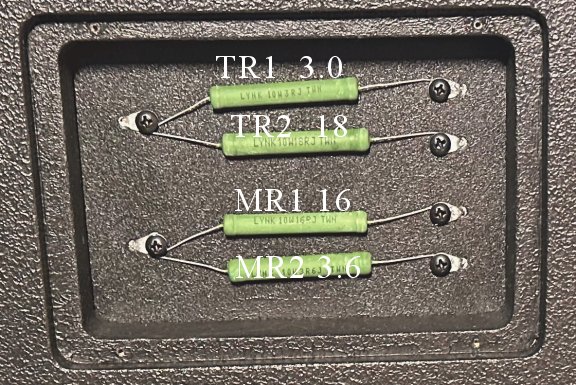Lucera Crossover Adjustments
The crossovers in the Lucera speakers offer a very nice feature, the ability for you to adjust the output level of the midrange and tweeter independently from the woofer output, providing flexibility in the overall voicing of the speaker. This is helpful to compensate for room variations, synergy with the electronics, or for simply tuning the system to one’s taste. It’s a feature that my customers tell me they really appreciate having. Why don’t all speakers offer this?
How To Make The Adjustments
First you’ll need to remove the four screws and the Lexan piece that covers the resistors. Use a #1 philips bit and remove the screws being very careful not to strip the screw heads and/or slip and damage the Lexan. When re-installing the screws, do not over-tighten.

You can adjust the output level of the midrange and tweeter in relation to the woofer (which always runs full output) by changing resistors on the back of each cabinet. Note the four resistors labeled in the photo above:
TR1 – Tweeter Primary
TR2 – Tweeter Shunt
MR1 – Midrange Primary
MR2 – Midrange Shunt
Here’s a closeup photo of a resistor

Nomenclature = “LYNK” is the brand – “10W” means 10 watt and “5R1J” means it is a 5.1ohm resistor. A 16ohm resistor would have 16R. The 5R1, 16R, etc… is the only part that you need to identify if/when you replace any of the resistors.
We refer to the resistors simply as four numbers, from top to bottom, corresponding to the tweeter and midrange resistor locations shown in the photo above.
Here are the factory installed resistors from top to bottom:
3.0
18
16
3.6
The top two are for the tweeter TR1 and TR2 and the bottom two numbers are for the midrange MR1 and MR2
You can raise or lower the output level of the tweeter or midrange by replacing the factory resistors with other combinations, using the chart below.
CHART
Tweeter Attenuation
-2db -1db 0 +1db +2db
TR1 4.3 3.6 3.0 2.4 2.4
TR2 15 16 18 22 30
Midrange Attenuation
-2db -1db 0 +1db +2db
MR1 16 16 16 16 16
MR2 2.7 3.0 3.6 4.3 5.1
Note the factory settings are highlighted in GREEN and shown as a ‘zero’ point. Note that the zero point is not really ‘0 db’, it is a starting point to reference the other attenuation options.
If you want to reduce the output level of the tweeter by one decibel, you would replace TR1 with a 3.6 and TR2 with a 16 and the new set would be:
3.6
16
16
3.6
Resistors are included with your Lucera to allow for +1db and -1db of midrange and tweeter.
Other resistor combinations are available to increase or reduce the output of the midrange and tweeter to a greater degree. Please send me an email and I’ll send you what you need.
A couple of notes: These are very minor changes to the output level. It’s possible that you may not even notice a 1db change in the midrange or tweeter output when you first make the change.
The factory setting is just a starting point. So please, don’t hesitate to try some different settings and take the time to get used to each change you make.
Have fun with it, and as always, you have my cell phone number and you can call me anytime for advice or help.
Note that the wires of the resistors are simply bent and shaped so that they make contact with the termination on the board, held in place by a screw. It is important that the wires make good contact with the termination for good signal transfer.
Even though the resistors have an outside coating, it is still a good idea to make sure that they do not make contact with one another after connecting them in place.
I’ll be the first to admit that connecting these resistors with looped wire ends does seem a little crude. But it’s actually a very good connection. Each wire behind the board has a tinned copper termination crimped to the copper wire and then the binding screws bind the loop of the tinned copper resistor wire directly to the termination. For a part that needs to be easily attached and detached, this is about as good a connection for optimum signal transfer as you can have.

Don’t want to be bothered? No problem, just leave the factory settings as they are and enjoy!
You won’t be disappointed, we promise. Lucera speakers sound wonderful as they are, direct from the factory. During the development, there was serious consideration given to NOT providing these adjustments due to the fact that it can turn some customers off. If the adjustments are really too much to deal with, we suggest putting it out of your mind and pretend you’ve received these fine speakers that do not offer, nor require crossover adjustments. Then enjoy the heck out of them just the way they are!
